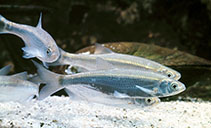| Family: |
Leuciscidae (Minnows), subfamily: Leuciscinae |
| Max. size: |
25 cm TL (male/unsexed); max.weight: 60.0 g |
| Environment: |
benthopelagic; freshwater; brackish; pH range: 7; dH range: 10; depth range - 1 m, potamodromous |
| Distribution: |
Europe and Asia: most of Europe north of Caucasus, Pyrénées and Alps, eastward to Ural and Emba. Naturally absent from Iberian Peninsula, Adriatic and Aegean basins (except Maritza drainage), Italy, Ireland, Great Britain (except southeast), Norway and Scandinavia north of 67°N, Caspian basin south of Volga. In Anatolia, Marmara basin. Locally introduced in Spain, Portugal and Italy. At least one country reports adverse ecological impact after introduction. |
| Diagnosis: |
Dorsal spines (total): 2-4; Dorsal soft rays (total): 7-9; Anal spines: 3-3; Anal soft rays: 14-20; Vertebrae: 41-44. Diagnosed from congeners in Europe by the possession of the following characters: origin of anal fin below branched dorsal rays 4-5; lateral line with 45-48 + 3 scales; anal fin with 17-20½ branched rays; 16-22 gill rakers; ventral keel exposed from anus to pelvic base; lateral stripe absent in life, faint or absent in preserved specimens; and mouth slightly superior (Ref. 59043). Caudal fin with 19 rays (Ref. 2196). Also Ref. 40476. |
| Biology: |
Inhabits open waters of lakes and medium to large rivers. Forms large aggregations in backwaters and other still waters during winter. Adults occur in shoals near the surface. Larvae live in littoral zone of rivers and lakes while juveniles leave shores and occupy a pelagic habitat, feeding on plankton, drifting insects or invertebrates fallen on the water surface (Ref. 59043). Feeds mainly on plankton, including crustaceans (Ref. 30578) and insects (Ref. 9696). Spawns in shallow riffles or along stony shores of lakes, occasionally above submerged vegetation (Ref. 59043). Excellent as bait for carnivorous fishes. May be captured using the smallest hook and a fly as bait. Its flesh is tasty (Ref. 30578). Of little interest to commercial or sport fisheries in its native range because of its small size (Ref. 1739). Scales were previously utilized in making Essence d"Orient, a coating for artificial pearls (Ref. 59043). |
| IUCN Red List Status: |
Least Concern (LC); Date assessed: 01 January 2008 Ref. (130435)
|
| Threat to humans: |
|
Source and more info: www.fishbase.org. For personal, classroom, and other internal use only. Not for publication.

